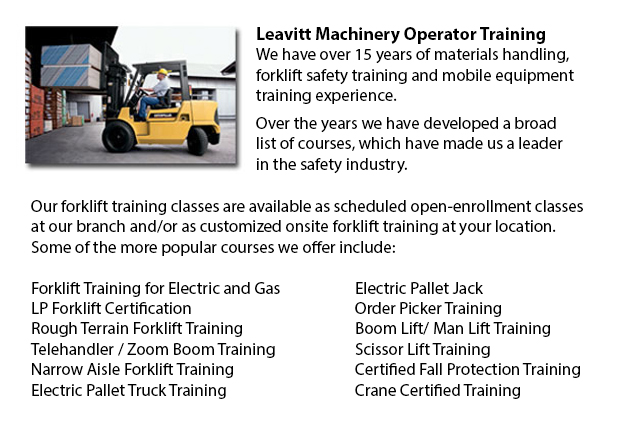
Forklift Training Programs Edmonton - If you are searching for work as an operator of a forklift, our regulatory-compliant lift truck training programs provide excellent instruction in numerous styles and types of forklifts, classes on pre-shift inspection, fuel types and handling of fuels, and safe utilization of a forklift. Hands-on, practical training assists individuals participating in obtaining fundamental operational skills. Course content covers existing rules governing the use of forklifts. Our proven forklift courses are designed to provide training on these types of trucks: narrow isle forklift, counterbalanced forklift and powered pallet truck.
How to Safely Handle Loads
Do not lower or raise the fork whilst the forklift is traveling. A load must not extend over the backrest because of the possibility of the load sliding back toward the operator. Inspect for overhead obstacles and make sure there is sufficient clearance before lifting a load. Stay away from overhead power lines. Once the load is lifted straight up, tilt it slightly back.
While the load is lifted the forklift would be less steady. Make sure that no pedestrians cross beneath the elevated fork. The operator should never leave the forklift when the load is lifted.
The forks must be level when handling pallets, and high enough to extend all the way into and beneath the load. The width of the forks should provide even distribution of weight.
Set the brakes and chock the wheels before unloading and loading the truck. The floors must be strong enough to support the weight of both the forklift and its load. Fixed jacks could be installed in order to support a semi-trailer which is not attached to a tractor. The height of the entrance door must clear the forklift height by at least 5 cm. Mark edges of docks, rail cars or ramps and avoid them.
Do not stay inside a forklift for a long time without right ventilation. The inside of the truck should be well lighted and free of loose objects, obstructions and trash. Check for holes in the floor. The installation of material that are non-slip on the floor will help prevent slipping. Clear any obstructions from docks and dockplates and make sure surfaces are not wet or oily.
Lift trucks should not be used to push or tow other forklifts.
-
Heavy Equipment Training School Edmonton
Heavy Equipment Training School Edmonton - The heavy equipment operator courses will assist the operator in acquiring the required skills and knowledge they will require to be able to enter the workforce as an entry level operator. In this 12 week co... More -
Manlift Ticket Edmonton
Manlift Ticket Edmonton - The Elevated Platforms and Manlifts Certification program helps to provide the necessary training on the safe operating procedures, work practice, rules and regulations regarding the daily activities for the operators of thi... More -
Crane License Edmonton
Crane License Edmonton - Crane operators must be "credentialed", which means they must have a crane operator license or certification. Credentialing is considered a mandatory governmental requirement in order to practice as a crane operator. Having a... More -
Counterbalance Forklift License Edmonton
Counterbalance Forklift License Edmonton - When operated by totally trained operators, forklifts could become a major advantage for firms and companies. We could offer your staff a comprehensive training program which covers all aspects of operating... More -
Manlift Safety Training Edmonton
Manlift Safety Training Edmonton - Manlift operators have to be aware and cognizant of all the potential hazards which are associated with particular types of scissor lifts. They need to be able to operate the scissor lift in a way that protects not... More -
Forklift Training School Edmonton
Forklift Training School Edmonton - Forklift Training School And Reasons Why It Is Really Important - Industry and federal regulators have established the criteria for forklift safety training based on their existing standards and regulations. Indivi... More -
Overhead Crane Safety Training Edmonton
Overhead Crane Safety Training Edmonton - The overhead crane safety training course is designed to equip the operators with the right skills and knowledge in the areas of: crane safety precautions, materials handling, accident avoidance, and equipmen... More -
Crane Certification Edmonton
Crane Certification Edmonton - The Crane Certification training program covers subject matter suggested by industry regarding the efficient and safe operation of cranes. People training will be taught the following: how to identify cranes and their c... More

Forklift Training Edmonton
crossorigin="anonymous">
TOLL FREE: 1-888-254-6157
Edmonton, Alberta
forklifttrainingedmonton.com
Email Us
About Us


